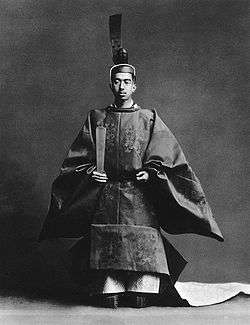Shaku (ritual baton)

Shaku (笏) or Hu (Chinese: 笏; pinyin: hù) is a ritual tablet or flat scepter of Chinese origin, which is used in Japan and also currently or historically in China, Korea, Vietnam and Ryukyu.
The Hu was originally used at court for the taking of notes and was usually made of bamboo. Officials could record speaking notes on the tablet ahead of the audience, and record the Emperor's instructions during the audience. Likewise the Emperor could use it for notes during ceremonies. It eventually evolved into a ritual implement. It also became customary for officials to shield their mouths with their hu when speaking to the Emperor. The hu can be made of different material according to the holder's rank: sovereigns used jade (similar to, but not the same as, the ceremonial jade scepter gui 圭), nobles used ivory, and court officials used bamboo. Japanese shaku is usually made of woods like Japanese yew, holly, cherry, sakaki or Japanese cedar.[1] It also became a religious instrument in Taoism and Shintoism.
The hu or shaku is often seen in portraits of Chinese Mandarins, Japanese shoguns, emperors and noblemen, but is now used mostly by Taoist priests (daoshi) and Shinto priests (the kannushi).
Use in China
The use of the hu as a ritual baton originated in ancient China, where the Classic of Rites required a hu to have a length of two chi six cun, (and its) mid part has a width of three cun("笏長二尺六寸,中宽三寸。")
In China it was customary to hold the hu with the broad end down and the narrow end up. This is the opposite of Japanese practice.
From the Jin dynasty onwards, with the proliferation of paper, the hu became a ceremonial instrument.
During the Tang dynasty, court etiquette required officials to wear the hu in their belts when riding horses.[2] The Chancellor was provided with a hu rack, which was carried into the palace. After an audience, the hu could be left on the rack. Lesser officials had hu bags, which were held by their attendants.[3] During the early Tang dynasty, mandarins of the fifth rank or above used ivory hu, while those below used wooden ones. The rules were further elaborated later to require that mandarins of the third rank or above used hu which were curved at the front and straight at the back, while those of the fifth rank or above used hu which were curved at the front and angled at the back. The hu used by lower rank mandarins were made of bamboo and were angled at the top and square at the bottom.
In the Ming dynasty, mandarins of the fourth rank or above used ivory hu, while those of the fifth rank or below used wooden ones.[4]
The hu fell out of use in the Qing dynasty. The greater ceremonial deference demanded by Qing emperors meant that officials had to greet the emperor by kowtowing, making it impractical to carry the hu to an audience.
Use in Japan
The standard reading in Japanese for the character used to write shaku is kotsu, but that is also one of the readings for the character bone (骨 hone) and is thus avoided to prevent bad luck.[1] The character's unusual pronunciation seems to derive from the fact the baton is approximately one shaku (an old unit of measurement equivalent to 30.3 cm) in length.[1]
A shaku or teita (手板) is a baton or scepter about 35 cm long held vertically in the right hand, and was traditionally part of a nobleman's formal attire (the sokutai, see photo).[5] Today it is used however mostly by Shinto priests during functions, not only with a sokutai but with other types of formal clothing as the Jōe, the kariginu (狩衣) and the ikan (衣冠).[1][5] The Emperor's shaku is more or less square at both ends, while a retainer's is rounded above and square at the bottom.[6] Both become progressively narrow towards the bottom.[6] Oak is considered the best, followed in order by holly, cherry, sakaki and Japanese cedar.[6]
The shaku originally had a strip of paper attached to the back containing instructions and memoranda for the ceremony or event about to take place, but it later evolved into a purely ceremonial implement meant to add solemnity to rituals.[1] According to the Taiho Code, a set of administrative laws implemented in the year 701, nobles of the fifth rank and above had to use an ivory shaku, while those below that rank were to use oak, Japanese yew, holly, cherry, sakaki, Japanese cedar, or other woods.[1][5] Ivory, however, was too hard to obtain, and the law was changed.[6] The Engishiki, a Japanese book of laws and regulations written in 927, permits to all the use of shaku of unfinished wood, except when wearing special ceremonial clothes called reifuku (礼服).[1][5]
Gallery

 Shogun Minamoto no Sanetomo, Japan
Shogun Minamoto no Sanetomo, Japan Two kannushi in Kyoto, Japan
Two kannushi in Kyoto, Japan A Taoist priest in Gangshan, Taiwan
A Taoist priest in Gangshan, Taiwan
References
- 1 2 3 4 5 6 7 Iwanami Kōjien (広辞苑) Japanese dictionary, 6th Edition (2008), DVD version
- ↑ 《舊唐書‧張九齡傳》記載︰"故事︰皆搢笏於帶,而後乘馬,九齡體羸,常使人持之,因設笏囊。"
- ↑ 《云仙杂记·笏囊笏架》:" 会昌以来,宰相朝则有笏架,入禁中,逐门传送至殿前,朝罢则置于架上。百寮则各有笏囊,亲吏持之。
- ↑ 《正字通》上載︰"明制,笏,四品以上用象牙,五品以下用木。"
- 1 2 3 4 Encyclopedia of Shinto. "Shaku". Kokugakuin University. Retrieved 2009-10-06.
- 1 2 3 4 Takada, Shizuo. "Shaku". Nihon Daihyakka Zensho Online (in Japanese). Shogakukan. Retrieved 2009-10-13.